Baddeley's Working Memory Model: Impact on Memory Research Field
VerifiedAdded on 2023/04/22
|7
|1795
|423
Essay
AI Summary
This essay explores the historical impact and significance of Baddeley's Working Memory Model in the field of memory research. It begins by establishing the model as a foundational theory, akin to Dalton's Atomic Theory, that differentiated working memory from short-term memory. The essay traces t...

1
Paraphrase This Document
Need a fresh take? Get an instant paraphrase of this document with our AI Paraphraser
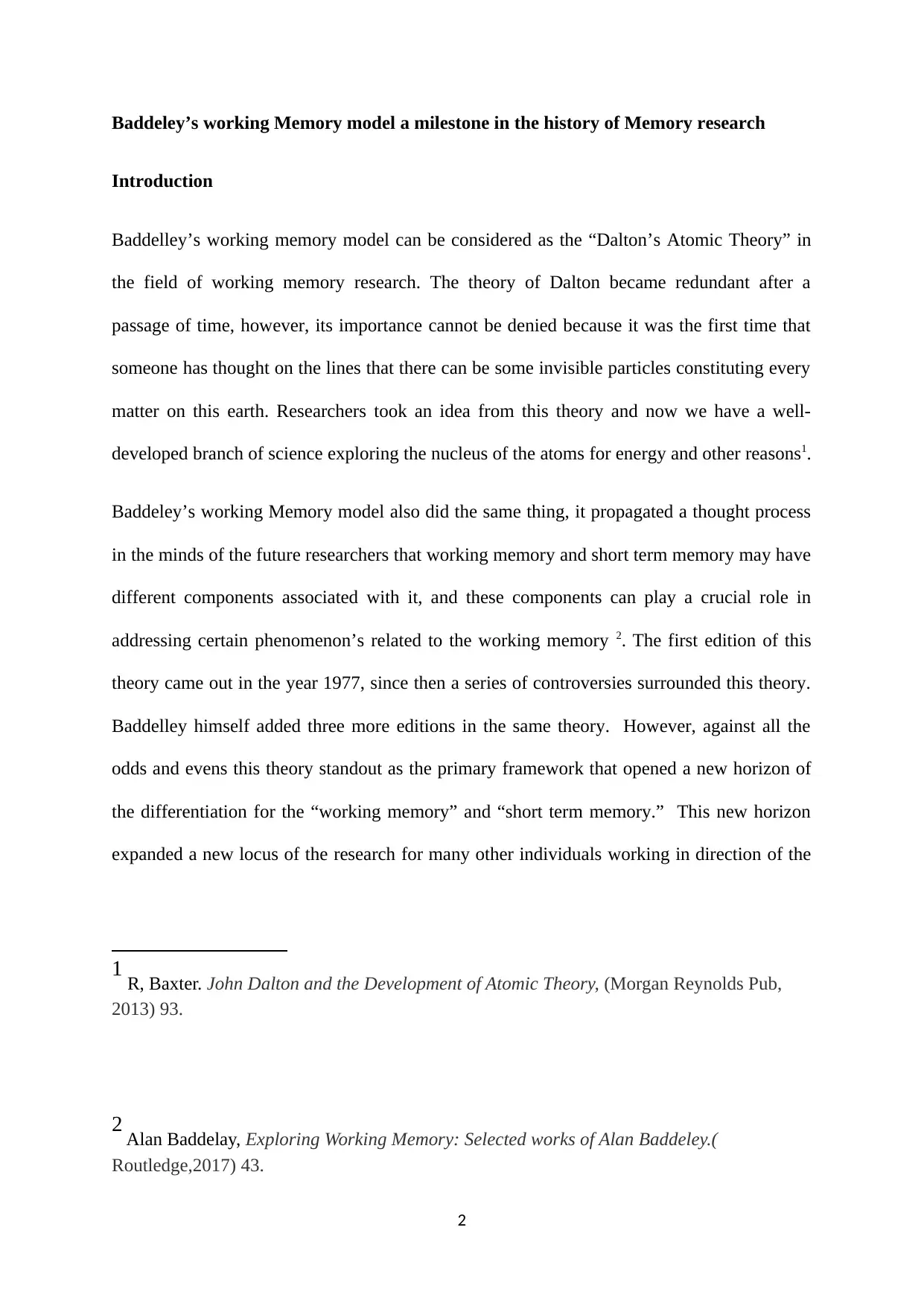
Baddeley’s working Memory model a milestone in the history of Memory research
Introduction
Baddelley’s working memory model can be considered as the “Dalton’s Atomic Theory” in
the field of working memory research. The theory of Dalton became redundant after a
passage of time, however, its importance cannot be denied because it was the first time that
someone has thought on the lines that there can be some invisible particles constituting every
matter on this earth. Researchers took an idea from this theory and now we have a well-
developed branch of science exploring the nucleus of the atoms for energy and other reasons1.
Baddeley’s working Memory model also did the same thing, it propagated a thought process
in the minds of the future researchers that working memory and short term memory may have
different components associated with it, and these components can play a crucial role in
addressing certain phenomenon’s related to the working memory 2. The first edition of this
theory came out in the year 1977, since then a series of controversies surrounded this theory.
Baddelley himself added three more editions in the same theory. However, against all the
odds and evens this theory standout as the primary framework that opened a new horizon of
the differentiation for the “working memory” and “short term memory.” This new horizon
expanded a new locus of the research for many other individuals working in direction of the
1 R, Baxter. John Dalton and the Development of Atomic Theory, (Morgan Reynolds Pub,
2013) 93.
2 Alan Baddelay, Exploring Working Memory: Selected works of Alan Baddeley.(
Routledge,2017) 43.
2
Introduction
Baddelley’s working memory model can be considered as the “Dalton’s Atomic Theory” in
the field of working memory research. The theory of Dalton became redundant after a
passage of time, however, its importance cannot be denied because it was the first time that
someone has thought on the lines that there can be some invisible particles constituting every
matter on this earth. Researchers took an idea from this theory and now we have a well-
developed branch of science exploring the nucleus of the atoms for energy and other reasons1.
Baddeley’s working Memory model also did the same thing, it propagated a thought process
in the minds of the future researchers that working memory and short term memory may have
different components associated with it, and these components can play a crucial role in
addressing certain phenomenon’s related to the working memory 2. The first edition of this
theory came out in the year 1977, since then a series of controversies surrounded this theory.
Baddelley himself added three more editions in the same theory. However, against all the
odds and evens this theory standout as the primary framework that opened a new horizon of
the differentiation for the “working memory” and “short term memory.” This new horizon
expanded a new locus of the research for many other individuals working in direction of the
1 R, Baxter. John Dalton and the Development of Atomic Theory, (Morgan Reynolds Pub,
2013) 93.
2 Alan Baddelay, Exploring Working Memory: Selected works of Alan Baddeley.(
Routledge,2017) 43.
2
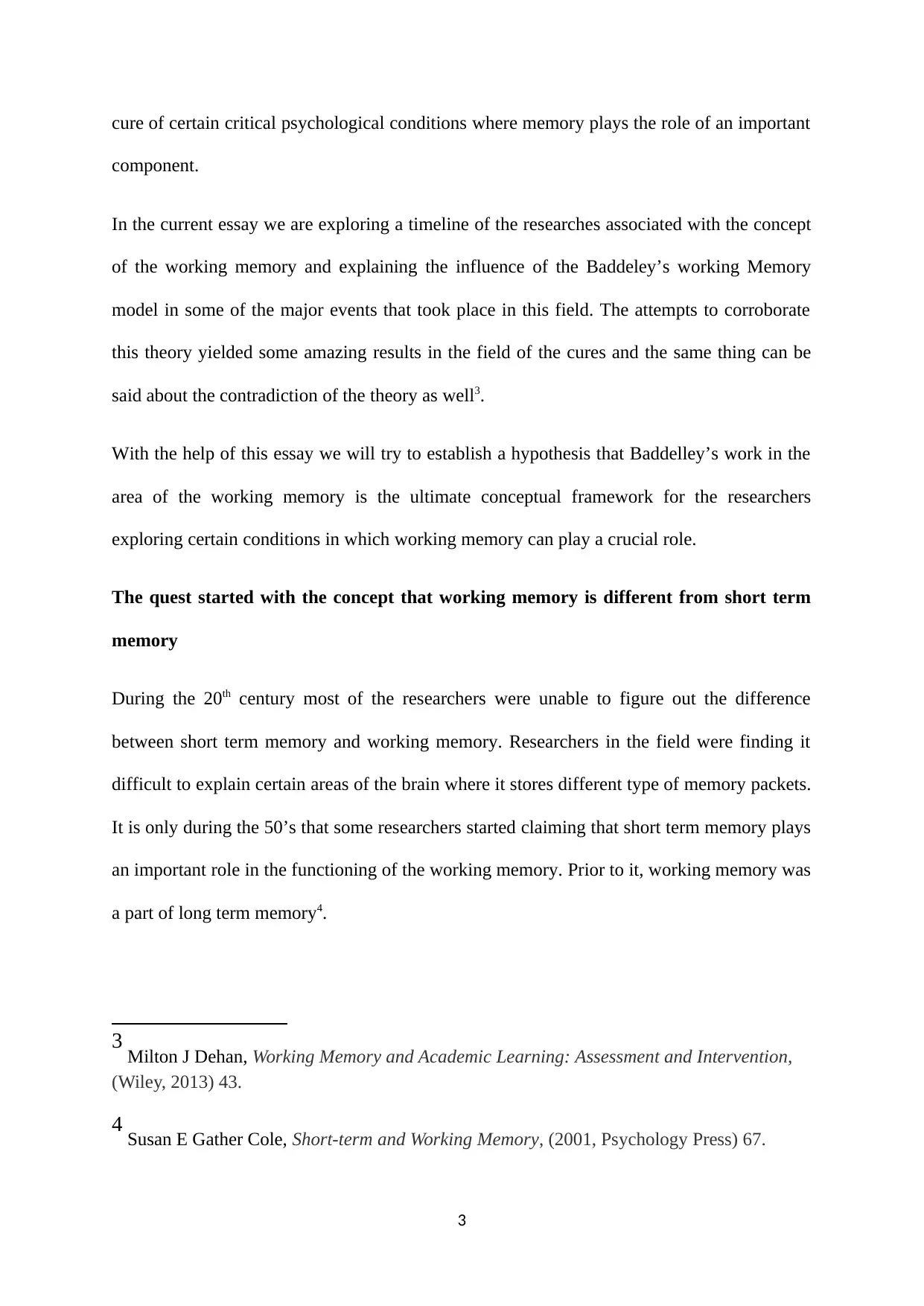
cure of certain critical psychological conditions where memory plays the role of an important
component.
In the current essay we are exploring a timeline of the researches associated with the concept
of the working memory and explaining the influence of the Baddeley’s working Memory
model in some of the major events that took place in this field. The attempts to corroborate
this theory yielded some amazing results in the field of the cures and the same thing can be
said about the contradiction of the theory as well3.
With the help of this essay we will try to establish a hypothesis that Baddelley’s work in the
area of the working memory is the ultimate conceptual framework for the researchers
exploring certain conditions in which working memory can play a crucial role.
The quest started with the concept that working memory is different from short term
memory
During the 20th century most of the researchers were unable to figure out the difference
between short term memory and working memory. Researchers in the field were finding it
difficult to explain certain areas of the brain where it stores different type of memory packets.
It is only during the 50’s that some researchers started claiming that short term memory plays
an important role in the functioning of the working memory. Prior to it, working memory was
a part of long term memory4.
3 Milton J Dehan, Working Memory and Academic Learning: Assessment and Intervention,
(Wiley, 2013) 43.
4 Susan E Gather Cole, Short-term and Working Memory, (2001, Psychology Press) 67.
3
component.
In the current essay we are exploring a timeline of the researches associated with the concept
of the working memory and explaining the influence of the Baddeley’s working Memory
model in some of the major events that took place in this field. The attempts to corroborate
this theory yielded some amazing results in the field of the cures and the same thing can be
said about the contradiction of the theory as well3.
With the help of this essay we will try to establish a hypothesis that Baddelley’s work in the
area of the working memory is the ultimate conceptual framework for the researchers
exploring certain conditions in which working memory can play a crucial role.
The quest started with the concept that working memory is different from short term
memory
During the 20th century most of the researchers were unable to figure out the difference
between short term memory and working memory. Researchers in the field were finding it
difficult to explain certain areas of the brain where it stores different type of memory packets.
It is only during the 50’s that some researchers started claiming that short term memory plays
an important role in the functioning of the working memory. Prior to it, working memory was
a part of long term memory4.
3 Milton J Dehan, Working Memory and Academic Learning: Assessment and Intervention,
(Wiley, 2013) 43.
4 Susan E Gather Cole, Short-term and Working Memory, (2001, Psychology Press) 67.
3
⊘ This is a preview!⊘
Do you want full access?
Subscribe today to unlock all pages.

Trusted by 1+ million students worldwide
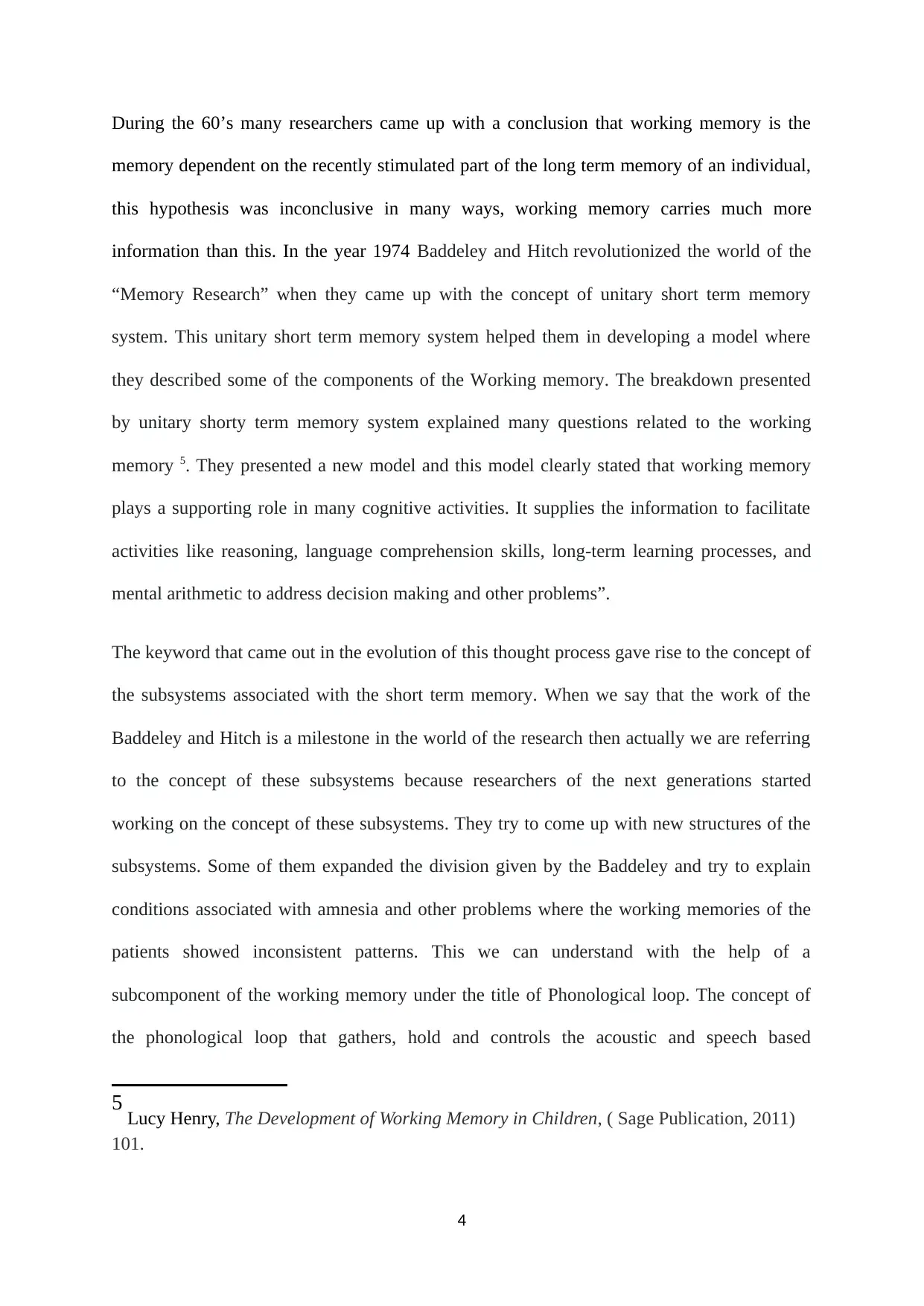
During the 60’s many researchers came up with a conclusion that working memory is the
memory dependent on the recently stimulated part of the long term memory of an individual,
this hypothesis was inconclusive in many ways, working memory carries much more
information than this. In the year 1974 Baddeley and Hitch revolutionized the world of the
“Memory Research” when they came up with the concept of unitary short term memory
system. This unitary short term memory system helped them in developing a model where
they described some of the components of the Working memory. The breakdown presented
by unitary shorty term memory system explained many questions related to the working
memory 5. They presented a new model and this model clearly stated that working memory
plays a supporting role in many cognitive activities. It supplies the information to facilitate
activities like reasoning, language comprehension skills, long-term learning processes, and
mental arithmetic to address decision making and other problems”.
The keyword that came out in the evolution of this thought process gave rise to the concept of
the subsystems associated with the short term memory. When we say that the work of the
Baddeley and Hitch is a milestone in the world of the research then actually we are referring
to the concept of these subsystems because researchers of the next generations started
working on the concept of these subsystems. They try to come up with new structures of the
subsystems. Some of them expanded the division given by the Baddeley and try to explain
conditions associated with amnesia and other problems where the working memories of the
patients showed inconsistent patterns. This we can understand with the help of a
subcomponent of the working memory under the title of Phonological loop. The concept of
the phonological loop that gathers, hold and controls the acoustic and speech based
5 Lucy Henry, The Development of Working Memory in Children, ( Sage Publication, 2011)
101.
4
memory dependent on the recently stimulated part of the long term memory of an individual,
this hypothesis was inconclusive in many ways, working memory carries much more
information than this. In the year 1974 Baddeley and Hitch revolutionized the world of the
“Memory Research” when they came up with the concept of unitary short term memory
system. This unitary short term memory system helped them in developing a model where
they described some of the components of the Working memory. The breakdown presented
by unitary shorty term memory system explained many questions related to the working
memory 5. They presented a new model and this model clearly stated that working memory
plays a supporting role in many cognitive activities. It supplies the information to facilitate
activities like reasoning, language comprehension skills, long-term learning processes, and
mental arithmetic to address decision making and other problems”.
The keyword that came out in the evolution of this thought process gave rise to the concept of
the subsystems associated with the short term memory. When we say that the work of the
Baddeley and Hitch is a milestone in the world of the research then actually we are referring
to the concept of these subsystems because researchers of the next generations started
working on the concept of these subsystems. They try to come up with new structures of the
subsystems. Some of them expanded the division given by the Baddeley and try to explain
conditions associated with amnesia and other problems where the working memories of the
patients showed inconsistent patterns. This we can understand with the help of a
subcomponent of the working memory under the title of Phonological loop. The concept of
the phonological loop that gathers, hold and controls the acoustic and speech based
5 Lucy Henry, The Development of Working Memory in Children, ( Sage Publication, 2011)
101.
4
Paraphrase This Document
Need a fresh take? Get an instant paraphrase of this document with our AI Paraphraser
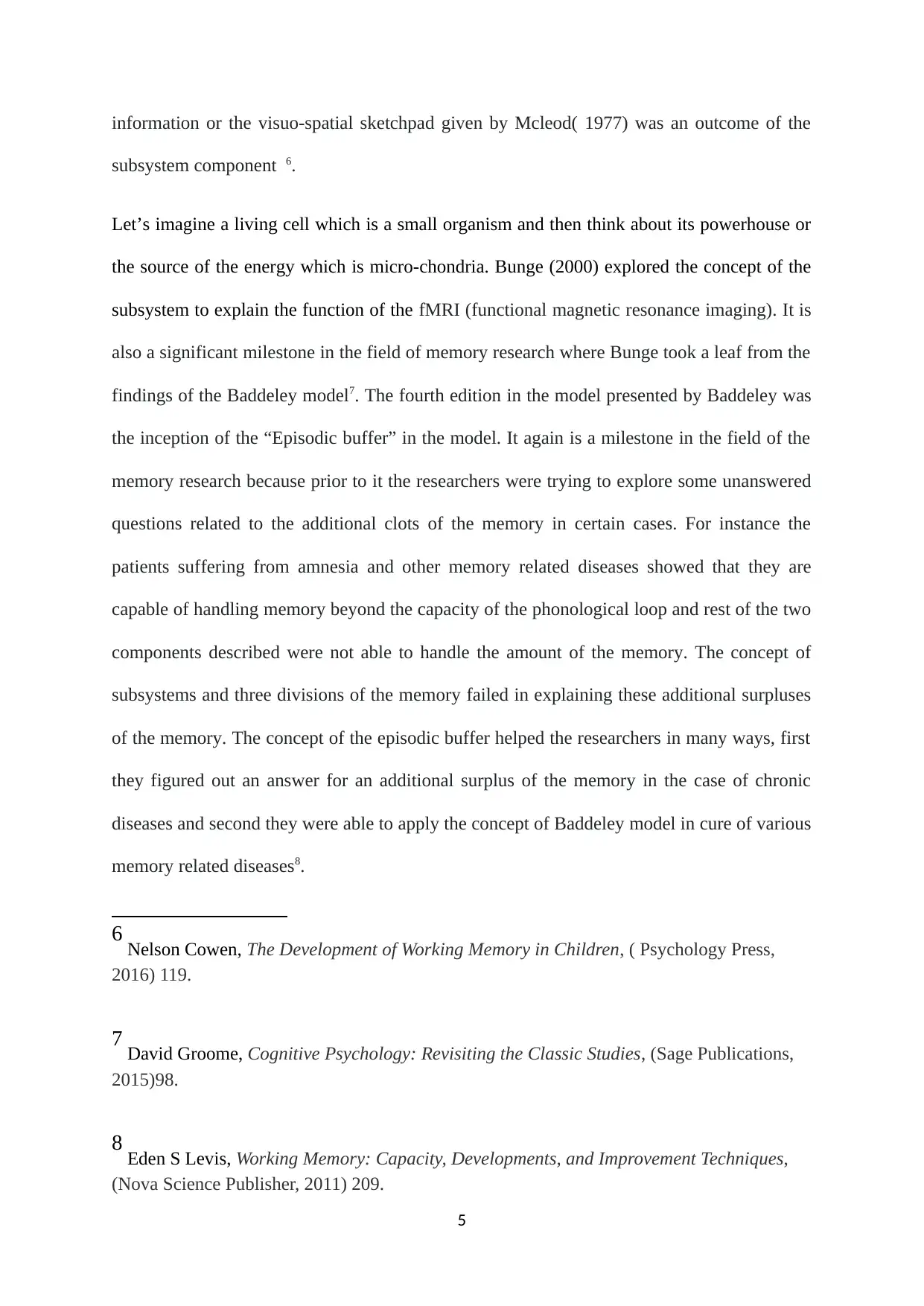
information or the visuo-spatial sketchpad given by Mcleod( 1977) was an outcome of the
subsystem component 6.
Let’s imagine a living cell which is a small organism and then think about its powerhouse or
the source of the energy which is micro-chondria. Bunge (2000) explored the concept of the
subsystem to explain the function of the fMRI (functional magnetic resonance imaging). It is
also a significant milestone in the field of memory research where Bunge took a leaf from the
findings of the Baddeley model7. The fourth edition in the model presented by Baddeley was
the inception of the “Episodic buffer” in the model. It again is a milestone in the field of the
memory research because prior to it the researchers were trying to explore some unanswered
questions related to the additional clots of the memory in certain cases. For instance the
patients suffering from amnesia and other memory related diseases showed that they are
capable of handling memory beyond the capacity of the phonological loop and rest of the two
components described were not able to handle the amount of the memory. The concept of
subsystems and three divisions of the memory failed in explaining these additional surpluses
of the memory. The concept of the episodic buffer helped the researchers in many ways, first
they figured out an answer for an additional surplus of the memory in the case of chronic
diseases and second they were able to apply the concept of Baddeley model in cure of various
memory related diseases8.
6 Nelson Cowen, The Development of Working Memory in Children, ( Psychology Press,
2016) 119.
7 David Groome, Cognitive Psychology: Revisiting the Classic Studies, (Sage Publications,
2015)98.
8 Eden S Levis, Working Memory: Capacity, Developments, and Improvement Techniques,
(Nova Science Publisher, 2011) 209.
5
subsystem component 6.
Let’s imagine a living cell which is a small organism and then think about its powerhouse or
the source of the energy which is micro-chondria. Bunge (2000) explored the concept of the
subsystem to explain the function of the fMRI (functional magnetic resonance imaging). It is
also a significant milestone in the field of memory research where Bunge took a leaf from the
findings of the Baddeley model7. The fourth edition in the model presented by Baddeley was
the inception of the “Episodic buffer” in the model. It again is a milestone in the field of the
memory research because prior to it the researchers were trying to explore some unanswered
questions related to the additional clots of the memory in certain cases. For instance the
patients suffering from amnesia and other memory related diseases showed that they are
capable of handling memory beyond the capacity of the phonological loop and rest of the two
components described were not able to handle the amount of the memory. The concept of
subsystems and three divisions of the memory failed in explaining these additional surpluses
of the memory. The concept of the episodic buffer helped the researchers in many ways, first
they figured out an answer for an additional surplus of the memory in the case of chronic
diseases and second they were able to apply the concept of Baddeley model in cure of various
memory related diseases8.
6 Nelson Cowen, The Development of Working Memory in Children, ( Psychology Press,
2016) 119.
7 David Groome, Cognitive Psychology: Revisiting the Classic Studies, (Sage Publications,
2015)98.
8 Eden S Levis, Working Memory: Capacity, Developments, and Improvement Techniques,
(Nova Science Publisher, 2011) 209.
5
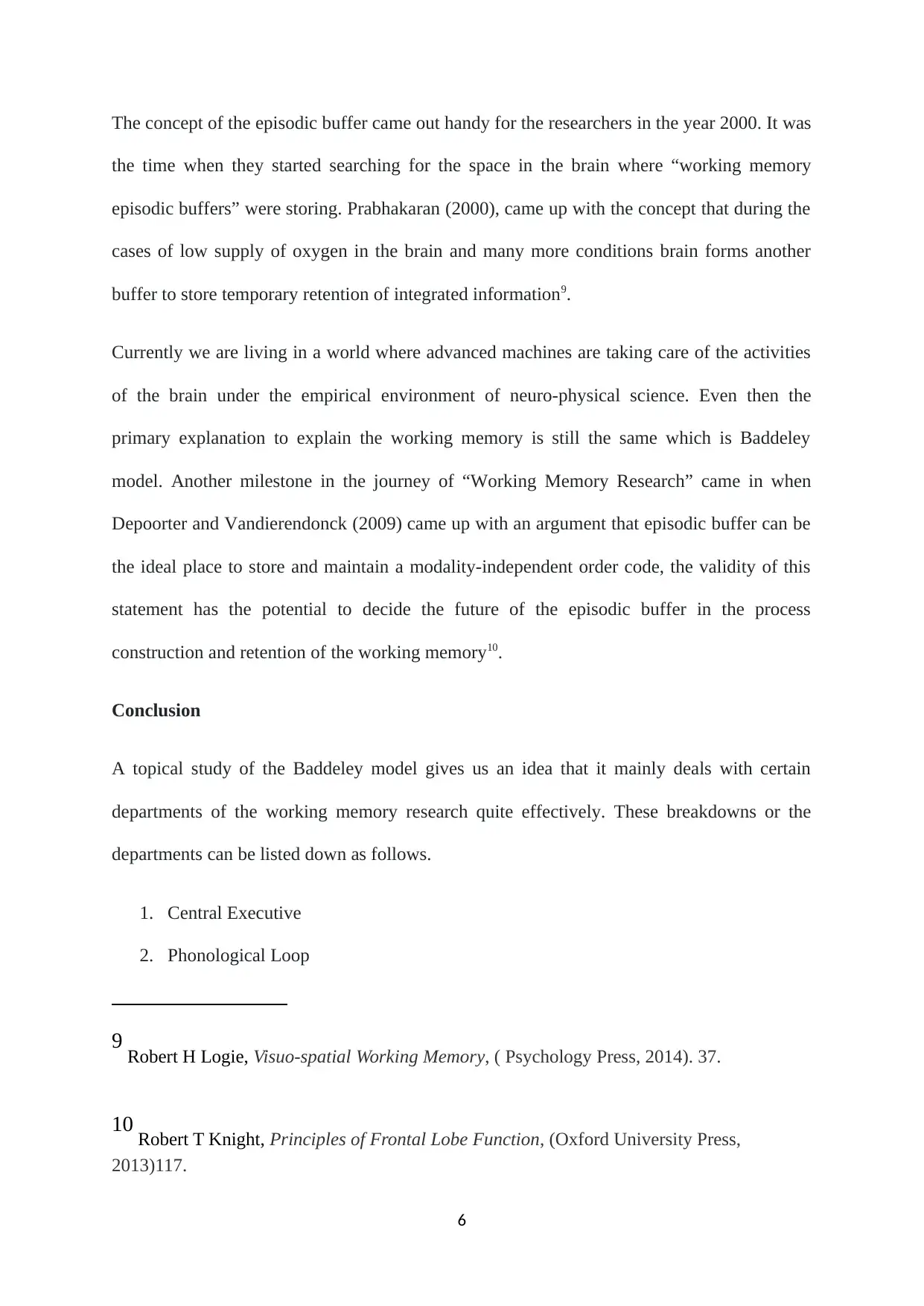
The concept of the episodic buffer came out handy for the researchers in the year 2000. It was
the time when they started searching for the space in the brain where “working memory
episodic buffers” were storing. Prabhakaran (2000), came up with the concept that during the
cases of low supply of oxygen in the brain and many more conditions brain forms another
buffer to store temporary retention of integrated information9.
Currently we are living in a world where advanced machines are taking care of the activities
of the brain under the empirical environment of neuro-physical science. Even then the
primary explanation to explain the working memory is still the same which is Baddeley
model. Another milestone in the journey of “Working Memory Research” came in when
Depoorter and Vandierendonck (2009) came up with an argument that episodic buffer can be
the ideal place to store and maintain a modality-independent order code, the validity of this
statement has the potential to decide the future of the episodic buffer in the process
construction and retention of the working memory10.
Conclusion
A topical study of the Baddeley model gives us an idea that it mainly deals with certain
departments of the working memory research quite effectively. These breakdowns or the
departments can be listed down as follows.
1. Central Executive
2. Phonological Loop
9 Robert H Logie, Visuo-spatial Working Memory, ( Psychology Press, 2014). 37.
10 Robert T Knight, Principles of Frontal Lobe Function, (Oxford University Press,
2013)117.
6
the time when they started searching for the space in the brain where “working memory
episodic buffers” were storing. Prabhakaran (2000), came up with the concept that during the
cases of low supply of oxygen in the brain and many more conditions brain forms another
buffer to store temporary retention of integrated information9.
Currently we are living in a world where advanced machines are taking care of the activities
of the brain under the empirical environment of neuro-physical science. Even then the
primary explanation to explain the working memory is still the same which is Baddeley
model. Another milestone in the journey of “Working Memory Research” came in when
Depoorter and Vandierendonck (2009) came up with an argument that episodic buffer can be
the ideal place to store and maintain a modality-independent order code, the validity of this
statement has the potential to decide the future of the episodic buffer in the process
construction and retention of the working memory10.
Conclusion
A topical study of the Baddeley model gives us an idea that it mainly deals with certain
departments of the working memory research quite effectively. These breakdowns or the
departments can be listed down as follows.
1. Central Executive
2. Phonological Loop
9 Robert H Logie, Visuo-spatial Working Memory, ( Psychology Press, 2014). 37.
10 Robert T Knight, Principles of Frontal Lobe Function, (Oxford University Press,
2013)117.
6
⊘ This is a preview!⊘
Do you want full access?
Subscribe today to unlock all pages.

Trusted by 1+ million students worldwide
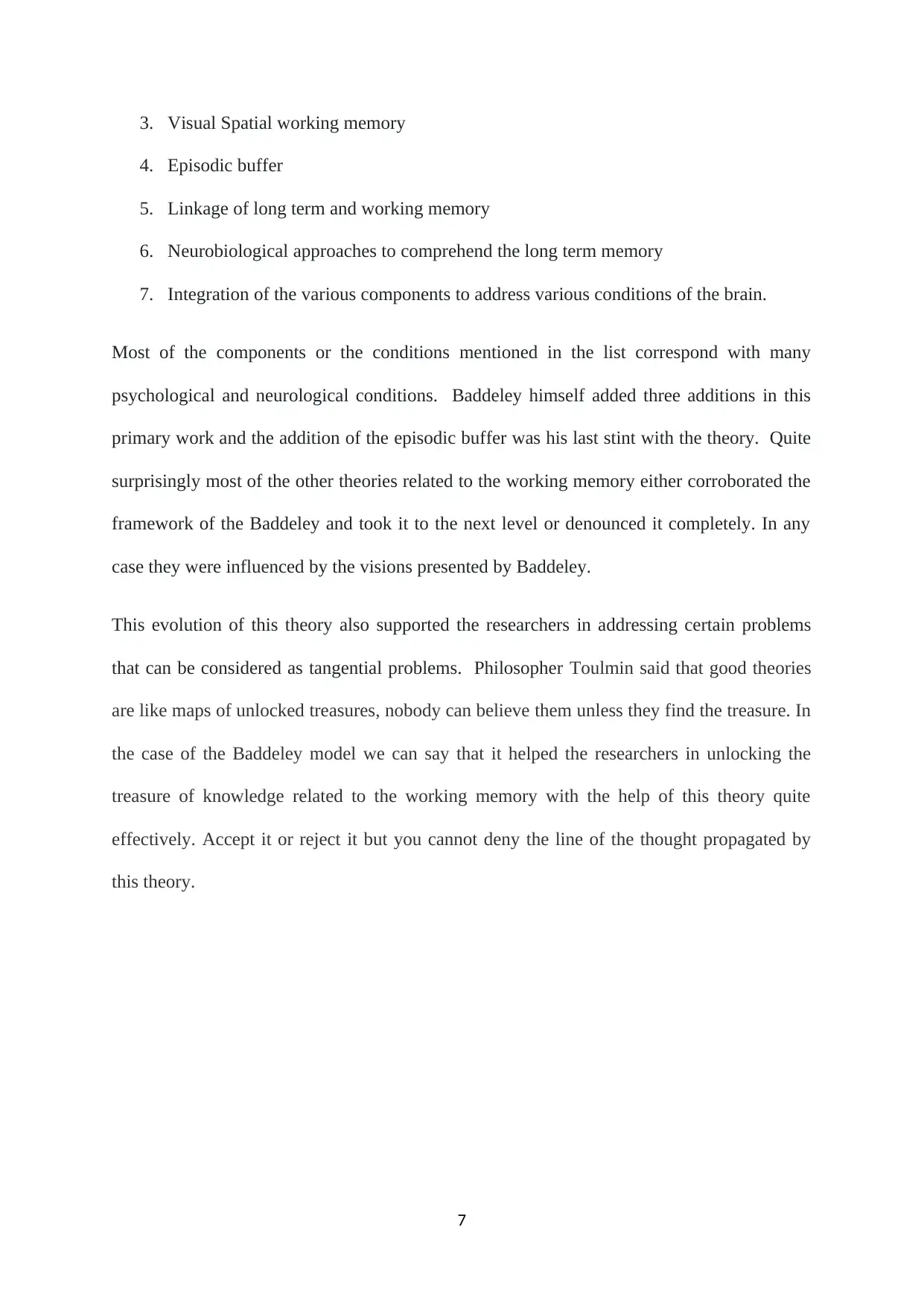
3. Visual Spatial working memory
4. Episodic buffer
5. Linkage of long term and working memory
6. Neurobiological approaches to comprehend the long term memory
7. Integration of the various components to address various conditions of the brain.
Most of the components or the conditions mentioned in the list correspond with many
psychological and neurological conditions. Baddeley himself added three additions in this
primary work and the addition of the episodic buffer was his last stint with the theory. Quite
surprisingly most of the other theories related to the working memory either corroborated the
framework of the Baddeley and took it to the next level or denounced it completely. In any
case they were influenced by the visions presented by Baddeley.
This evolution of this theory also supported the researchers in addressing certain problems
that can be considered as tangential problems. Philosopher Toulmin said that good theories
are like maps of unlocked treasures, nobody can believe them unless they find the treasure. In
the case of the Baddeley model we can say that it helped the researchers in unlocking the
treasure of knowledge related to the working memory with the help of this theory quite
effectively. Accept it or reject it but you cannot deny the line of the thought propagated by
this theory.
7
4. Episodic buffer
5. Linkage of long term and working memory
6. Neurobiological approaches to comprehend the long term memory
7. Integration of the various components to address various conditions of the brain.
Most of the components or the conditions mentioned in the list correspond with many
psychological and neurological conditions. Baddeley himself added three additions in this
primary work and the addition of the episodic buffer was his last stint with the theory. Quite
surprisingly most of the other theories related to the working memory either corroborated the
framework of the Baddeley and took it to the next level or denounced it completely. In any
case they were influenced by the visions presented by Baddeley.
This evolution of this theory also supported the researchers in addressing certain problems
that can be considered as tangential problems. Philosopher Toulmin said that good theories
are like maps of unlocked treasures, nobody can believe them unless they find the treasure. In
the case of the Baddeley model we can say that it helped the researchers in unlocking the
treasure of knowledge related to the working memory with the help of this theory quite
effectively. Accept it or reject it but you cannot deny the line of the thought propagated by
this theory.
7
1 out of 7
Your All-in-One AI-Powered Toolkit for Academic Success.
+13062052269
info@desklib.com
Available 24*7 on WhatsApp / Email
![[object Object]](/_next/static/media/star-bottom.7253800d.svg)
Unlock your academic potential
© 2024 | Zucol Services PVT LTD | All rights reserved.


